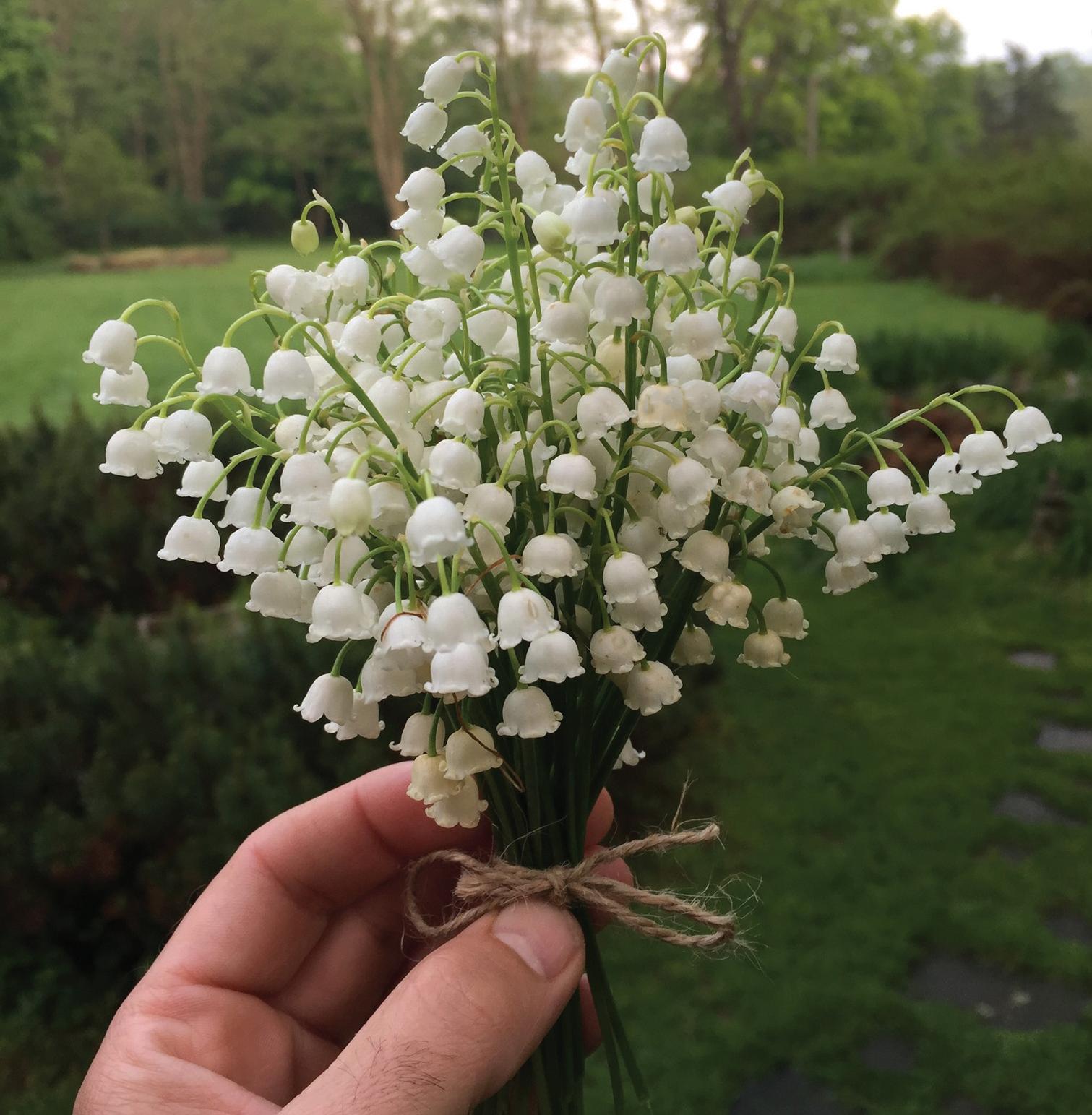
44 minute read
poem

Pandemic Blues
One foot in front of the other, Trying to carry on, Walking with abandon.
Digging deeper, Revealing raw emotions, My subconscious crumbles.
Pretending life is normal, How much longer, Must we march on?
Day by day we struggle, To scale a mountain, Can’t come soon enough.
Feeling crisp air, And sun shining through, My soul and hope are renewed!
-Maureen Newman



Chasing Her Dream
Liza Nechamkin Glasser Silversmith
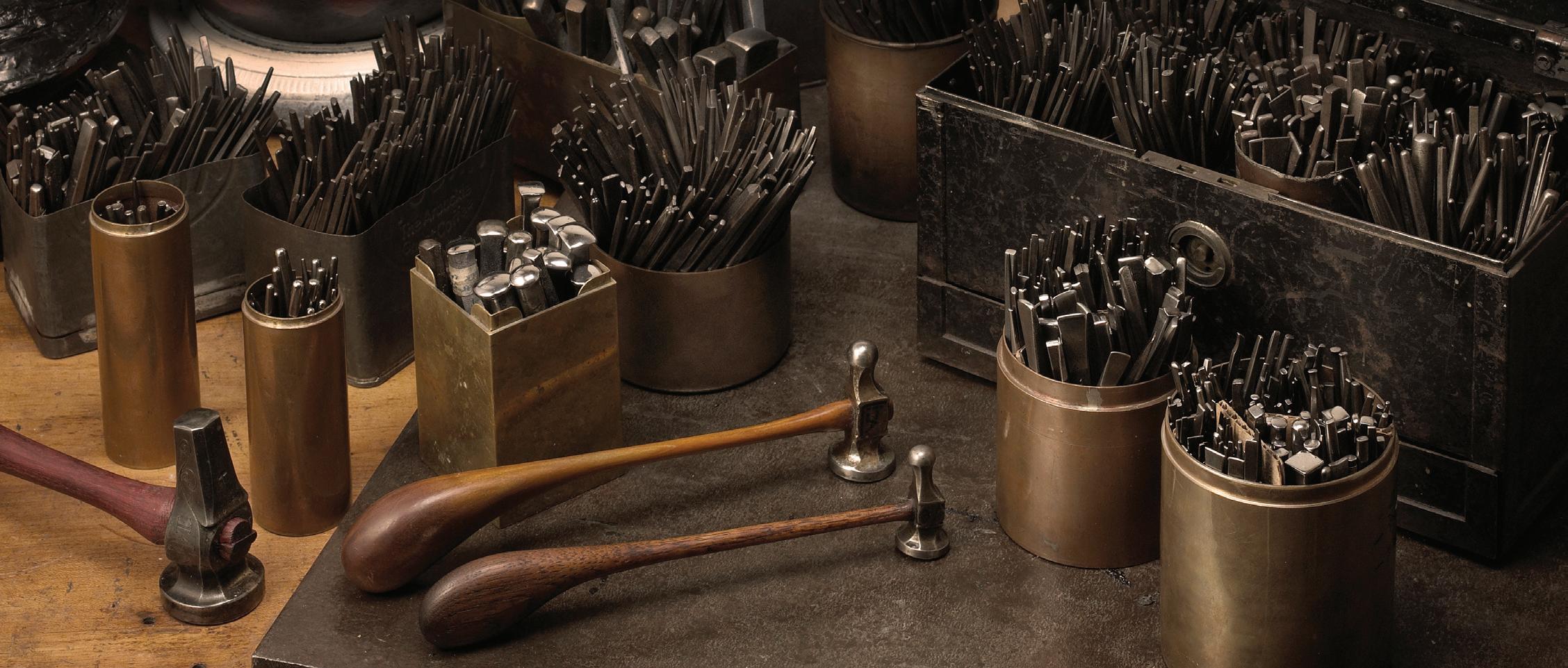
F
rom the time she was a child, Liza Nechamkin Glasser knew she wanted to eventually have her own business. It was a family thing.
“My grandfather owned his own business. My father trained as a civil engineer and had his own building construction business. So I was around people who owned their own businesses and were making things. And I learned to love making things, too.” It wasn’t much of a stretch for her to envision the idea of creating her own company. Since 1998, it has been the thriving concern, Nechamkin Silver Studios located in Andover, New Jersey.
Growing up in Mount Olive, NJ, Nechamkin took every art class in high school she could. “After the second year of math, I did the bare minimum of required academic courses in order to fit in more art curricula.” She excelled at art and took the usual drawing and painting classes. But one class, crafts, “had a dab of everything: textiles, weaving, ceramics, wood, and...jewelry making, which had a bit of metalworking as part of it.” She was immediately smitten—working in metal had stolen her heart.
Alas, her wise parents wanted her to be able to have a job once out of college. So they tried to steer her towards graphic design, which would likely land her a more regular, corporate job. She relates how she wound up at the Rochester Institute of Technology:
“I had gotten into the schools I applied to, including Rochester. Another was Bowling Green in Ohio, which we visited. After touring the campus and seeing the art department, we were pretty much set on my majoring in graphic design and going there. We had little to compare it to. But at the airport on our way back home, we met the father of the valedictorian of my class and started chatting. He told us his daughter was going to Rochester, and they were very excited she had gotten accepted. When he found out I was also accepted there, he was super-impressed and said we should go see the school. So we ended up visiting Rochester, and my parents decided I should go there, even though it was more money!”
Once on the Rochester campus, it took two weeks for Nechamkin to realize she belonged not in the Graphic Design Department, but in the Metal Shop. So she changed her major. “I was in love with working with metal. And I hated graphic design.” Her parents drove the five hours up to the school immediately but happily “came around” when her professor assured them that there would be a job waiting for her after graduation. And there was. At none other than Tiffany’s.
For thirteen years, Nechamkin worked as a “chaser” in the Hollowware and Trophy Shop. The chaser is a person who “draws” the outlines of designs on the front of metal pieces with various specialized tools. (Working on the back is called repoussage.) After three years of honing her skills, she became an official silversmith at Tiffany’s and had her own bench.
On the side, she made her own work, first in a friend’s unheated garage and then in the back of her father’s building company. “I made chalices. I made Torah ornaments and other things. I had work in galleries here and there. But I have always been drawn more to the trade aspect, rather than the fine art aspect of art. I didn’t want to make production pieces. I was more interested in repair work and specialty items.” So starting her own business was key.
In 1998 she did just that. Based in what used to be the construction company space of her father’s, she now manages the building and its other tenants along with all the silver work that comes her way.
be ready. “It takes thought and time as each piece is an individual problem waiting to be solved. I love working with intricate surface pieces. It doesn’t get boring because no two jobs are the same.”
Somewhere along the line, she made time for having a baby and worked around his schedule, only expanding hours once he was in school. This is a woman who clearly has a lot of energy and drive!
Over the years, she has also developed specialty tool sets for metalworking and tells me that these can bring in onethird to one-half of her income some years. They are sold online through various outlets, such as Otto Frei. You can find several YouTube videos that explain their use. (Search for “Nechamkin” and they will come up.) Of course there’s a Facebook page, too, Nechamkin Silver Studios, which is full of photos and information about her work and her tool sets.
I asked her what special pieces, if any, she has worked on. One that immediately comes to mind is the famous Wanamaker Trophy for the PGA, but she tells me she has made and repaired other trophies for various sporting events— too many to enumerate. Somehow, we get into talking about education and the fact that shop classes don’t exist in high schools anymore. She bemoans the lack of practical trade classes in high schools and worries that young people today “are illiterate with their hands. Work like I do uses skills. It calls for a lot of intellect. It’s so satisfying; not everyone has to work on computers!”
Would people be able to stop by her shop? Ms. Nechamkin goes on to mention that she offers free estimates, but isn’t set up time-wise for on-going tours of her studio. “I can occasionally bring a group of people here, but I’m so busy it’s hard to arrange that.” She does offer private, specialized classes for a couple of people at a time, but those are also rare events and must be scheduled ahead of time.
Last question: Has her passion subsided over the years? “No! Not really.” She is still exploring materials and processes and still learning. “I've taken a few blacksmithing classes and made some things in iron. It’s such a great material. I want to make more things in iron. I just love making things!” .................................................................................... Julia Schmitt Healy is an artist, educator, and writer who lives and works in Port Jervis, N.Y.




GLOSSARY
chasing • The process of refining the surface of metal by denting it. It is also done to make any punched or hammered decoration on metal. In the strict sense, the term is used to refer to any line applied with a tracer on the face of repousse work. repousse • The method of decorating metals in which parts of the design are raised by means of hammers and punches; definition and detail can then be added to the front side by chasing or engraving. engraving • Making incisions into a metal surface. hollowware • Serving dishes and accessories, often made of silver, that are hollow or concave. flatware • Spoons, forks, and serving implements used at the table. Term was introduced towards the end of the 19th century. silverware • Anything made of silver. cutlery • Referring to knives. silversmith • A metalworker who crafts objects from silver. jeweler • A person who makes, sells, and repairs jewelry and watches. goldsmith • A metalworker who specializes in working with gold and other precious metals. Today, they mostly specialize in jewelry-making. metal-spinning/spinner • Also known as spin forming or metal turning. A metalworking process by which a disc or tube of metal is rotated at high speed and formed into an axially symmetric part. It does not involve removal of material but rather, molding sheet metal over an existing shape. mandrel • A cylindrical rod around which metal or other material is forged or shaped. finishing • Process of changing the surface of an object for the purpose of improving its appearance and/or durability. caster • Someone who takes the molten liquid metal and pours it into cast or molds to form metal shapes that, when cooled, are sanded, ground, and polished before being completely finished. silver-plating • Covering a surface with a very thin layer of silver. pitch • Malleable material that is used to support your metal as you move it into the shape during chasing and repousse. ductility • Ability of a metal to receive permanent deformation without fracturing.


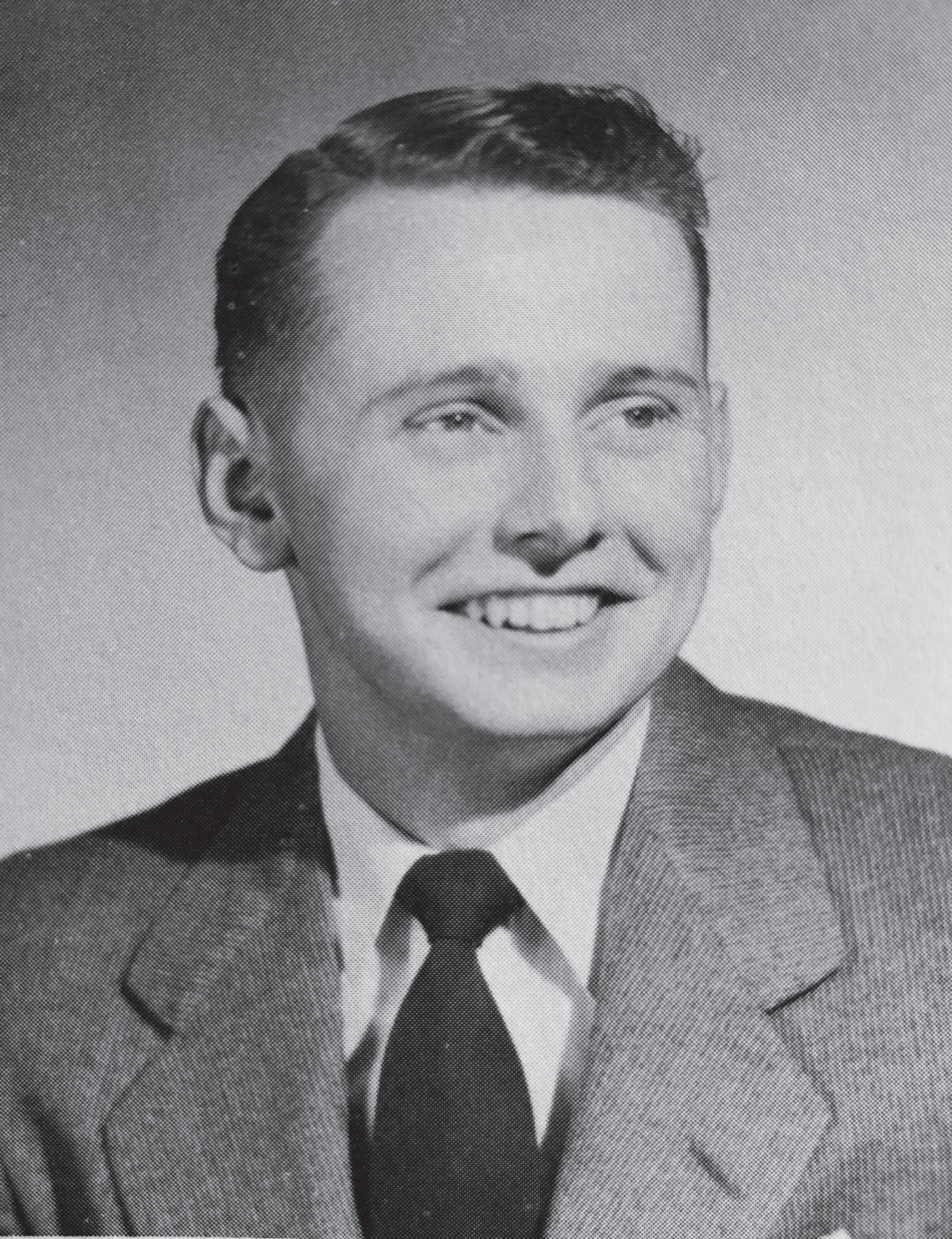
William Bathgate Bill
Hi, there, hot rod….likes women and food….always wears a smile and a big hello….active at all sports events….will hunt and swim whenever possible….an ardent friend of all game wardens… known as the Branchville Bomber.
A Memoir of My Father’s High School Years Fast Cars and Fist Fights
Well, you look like an old school marm,” my father tells me with a chuckle as I peer at him over the top of my readers. I was waiting for him to get started and to begin telling the tales that always seem to bring him to life, animated with a twinkle in his eyes. We were sitting across from each other at my parents’ kitchen table this day, and I was there to record those stories. The ones of pure, young spirit—and more than a little mischief—from his high school days so long ago.
“That is exactly what I am,” I reply with a grin of my own. If there is one thing that Dad has taught me, it is the ability to laugh at yourself. And so the tone was set, and we began.
Sometimes I’d ask a question or two, but for the most part I could just let him go, let him wistfully share those memories and stories of his heyday.
It was the fall of freshman year in 1952, and my dad had his first confrontation in the bowels of the old Newton High School on Halsted Street. His heart had been set on Pam, a pretty senior girl who had just broken up with her boyfriend, Roy, while he was serving in the Navy.
Heading down to the study-hall rooms in what was known as the Little Library below ground level, an upperclassman named Pete pinned Dad to the wall in the stairwell. “Stay away from Pam,” Pete warned. It turned out that he, too, was determined to win Pam’s affections. Dad then received a good hard punch in the stomach and was told that it was, “going to be a lot worse than that” if he didn’t stay away from Pam.
With that very one-sided interchange, the boys each moved on and went about their school day. But Dad had no intention of relenting in his pursuit.
Not too long after the incident in the stairwell, Dad and Pete’s paths crossed again. This time they were at the local roller rink near Lake Owassa. “Pete couldn’t skate worth a damn,” my father states. He went on to confess that he had boldly stuck his foot out as Pete skated past and sent his adversary toppling to the ground. was gonna give it to me.” Dad claims that just as he was face to face with Pete, a family friend who lived in the area stopped by and “saved my bacon.”
Dad and Pam never dated, and she ended up marrying a Marine who my father admits was a really nice guy.
The prime location of Newton High School at the end of Halstead Street, combined with a one-hour lunch break when students were set free on the streets of town, created an opportunity. This opportunity for students to have a short window of freedom manifested itself differently for each teen. Dad recalls Little George, for example, who was “a real tough nut,” picking fights that would come to fisticuffs at the entrance of the Newton Cemetery. This was in stark contrast to him and his friends who reaped the benefits of nearby Hershey’s juke joint, with its L-shaped lunch counter and stools, booths, juke box, and diner-style menu.
The school’s outer hallway doors opened towards the bottom of Halstead Hill, and Hershey’s, in plain sight, proved to be an irresistible temptation even during the school day.
One day, after attendance was taken in shop class and the room started to bustle with sawing and hammering, Dad and his buddies Colin and Herbie quietly cut out and headed down the hill. Having access to an oasis such as Hershey’s during the humdrum of a typical school day was pure joy. The guys loved to talk and laugh, drink soda and smoke, and just not be in school.
But that all came to a quick end when managers Len and Vince warned the boys that Principal Weaver was approaching quickly. The threesome ducked behind the counter and hid until their principal was satisfied with Len and Vince’s account that they had not seen anyone fitting those descriptions recently. As Weaver moved on, the boys were able to rush back up the hill and sneak back into class. Disciplinary action was avoided for yet another day.
By junior year, Newton High School had moved to a new location on Ryerson Avenue. Dad’s group had solidified itself, including John, Wayne, Herb, Colin, and Darryl. “Across the street from the school was the Campus Shop, and everybody would hang out there and have a good time every chance we got,” he remembers. It was another juke joint with loud music, good food, and comfortable booths,

but now there was also a pinball machine available in the basement. The scene was set, and the cast of characters knew their roles. Junior year began!
“Our friend Danny was our very own Fonzi, like in Happy Days, before there even was a Fonzi,” my dad recalls and his face beams. “He was the friendliest guy, with a duck ass haircut, black leather jacket, and black ’49 Mercury.” Often on mornings while the guys were heading into school, Danny would blow past them in that black Mercury. “Sayonara!” he’d yell, waving at the guys. One time, during another cruise by in his Mercury, Danny smashed head-on into an old oak tree. Astonishingly, he was okay other than sustaining a cut on his forehead.
Shortly after that incident, Danny quit high school and joined the Navy. It was several years later, while my dad was stationed in Boca Chica, that a squadron from New England flew into base. Dad was in the chow line with the visitors when he spotted Danny among them. The two were able to catch up on the years that had passed, as well as reminisce about the good old days. After serving in the Navy, Danny went on to work at Picatinny Arsenal as a federal police officer and was active in the local VFW.
Those good old days were highlighted by the pranks of energetic teen boys with time on their hands and mischief on their minds. This is how a young male teacher who dressed to the nines and drove a fancy little sports car found himself as one of their targets. “It wasn’t that we disliked him, it was just that we thought he was a little bit prim and proper,” Dad recalls.
When the crew noticed how this teacher carefully parked his car in a select spot each day, the plan was solidified. “Must have been about six of us,” Dad starts to recall, and the spark of a 17-year-old boy takes over his expression. The guys picked up that new teacher’s precious car and moved it to the doors of the school’s front entrance. They turned it sideways as they put the car down, ensuring that no one would be able to get in or out of the building from that location.
By noon that day, the guys were hanging out in the Campus Shop, wearing proud smiles of accomplishment. The group’s demeanor changed quickly when a teacher was spotted crossing Ryerson Avenue and approaching them. He seemed to know exactly who was to blame for the car that was blocking entrance to the school and where they could be found.
“I’ll give you guys 15 minutes to get that car out of the way,” the teacher demanded and walked away. The boys were up in an instant to return the car. True to form and needing to have the last laugh, they carefully placed it back in its parking spot alongside the road, but facing the opposite direction.
Not all of their pranks went so smoothly. It was during the big football game with Franklin, Newton’s number one rival, that a fist fight broke out between Colin and a student from the other school. The hostile, punch-throwing opponent menacingly told Colin that he was going to cut down Newton’s goal posts. Dad recalls that he and his friends decided that they would, “take things into our own hands.”
The first part of the plan was completed without issue. That night, they loaded an old logging chain and plow into the back of a pick-up truck and headed to Franklin’s football field. Cutting deep and long furrows across the field in the dark seemed to be the logical deed to prove athletic superiority. As the boys moved onto the field with the plough, they heard a stern voice cut through the dark. It was the Franklin Chief of Police, and he effortlessly threw each one of the boys into his squad car “like pieces of cordwood.” The perfect plan of revenge had been foiled, and punishments would be dealt out as parents were called to come and collect their sons from the Franklin Police Station.
School days continued, and my dad couldn’t help but notice that no matter how hard he tried, he could only manage grades that were just passing. His marks were middle to low Cs, as were those of most of his buddies, and they couldn’t figure out why.





teacher’s birthday was approaching. Knowing that she frequently enjoyed a stiff drink, the group knew exactly how they would procure the desired higher grade.
One of the boys was able to get ahold of a bottle of liquor, and he came to school on the teacher’s birthday with a carefully wrapped gift of Seagram’s 7. They placed the bottle in one of the Home Economic room’s ovens, and on their way out of class told her that they had left her a birthday gift in the oven. At the end of the term, the boys were delighted to see that they had earned higher marks in Home Economics.
There were other memorable teachers and classes that left a more meaningful impression on my father. During his senior year, Miss Quinn taught a class called, Problems of American Democracy. They discussed and studied current events, and Dad automatically respected this teacher. “No one gave her a hard time,” he recalls. The class was composed of seniors, as well as a young man who had served in Korea and returned home to finish high school.
At this point in his high school years, my dad had his own car. He admits that it may not have been as cool as the ’49 black Mercury driven by Danny, but Dad’s ’49 slope back, pea green Chevy with black and yellow checkerboard fender skirts left its own impression on his peers.
Every morning while driving himself to school with a buddy from Branchville, Dad would stop at the train station and pick up a supply of The New York Times that had been delivered and set aside for class. Most days he would make one more quick stop, to pick up Helen and Diane as they walked to school. He enjoyed being able to give these classmates a ride and wouldn’t have considered passing them by and leaving them to walk through snow or rain or cold. Besides, having more passengers in his car meant having more people to tell stories with and laugh.
By delivering that stack of newspapers to his Problems of American Democracy class at that time, he was providing the students with the most up-to-date news possible. My father was invested in this class and remembers feeling the importance of the lessons and discussions that took place. He knew even then that he had a great opportunity to learn from both a knowledgeable teacher and an experienced veteran.
In this class also, Dad yearned for a good grade to the point of nervousness. “Darryl would laugh at me ’cause I would get so worked up because of the grades.” He goes on to say, “Darryl was a guy who all through grade school and high school would take a class, never crack a book, and his grades were up at the top all the time.” ate that the only items Dad contributed to Miss Quinn’s lessons were the newspapers and his eagerness to learn.
Midway through senior year, Dad and his buddy Big John decided that there were too many underclassmen hanging out at the Campus Shop. Lunchtime then became a new adventure into town as every day my dad drove himself and his friend to the Newton Diner on Spring Street. This narrow diner, right across the street from the theater, offered a Blue Plate special that John simply could not resist. Dad was on a much tighter budget, and the waitress allowed him to eat his bag lunch as long as he purchased a soda or slice of pie. Meanwhile, Big John ran a tab as he enjoyed the special and half a pie each day. John would faithfully pay his tab in full at the end of each month and start running a new one the very next school day.
They had fast cars and fist fights. They hung out in juke joints like Hershey’s and the Campus Shop. While this crew of kids, members of the Newton High School class of 1956, were bold and brazen in their actions, they also granted respect to others accordingly. The guys became men as they went on to serve their country, raise families, and make meaningful contributions to their communities.
High school days faded into the background and became the paradigm of “The Good Old Days,” to be fondly remembered. “Whenever I see Happy Days and I see that jukebox and Fonzi, I think of Danny and everybody else,” my dad says drawing a parallel between the once popular television show and his own heyday in high school.
As my time with Dad came to a close that day, I realized how very fortunate I was that he had shared these stories with me. Watching him come to life across the kitchen table and listening as he would spin a yarn, I knew that the stories as well as this moment itself were all precious. They were the anecdotes that held within them the spirit of younger days, the makings of a generation, and the revelation that the depth of one’s character is built upon a myriad of life experiences.
“Well, that’s how I remember it,” Dad says as he sits back in his chair and winds down his storytelling. “I don’t know if they remember it the same way, but the people I remember are the people who affect my life today.” With that acknowledgment, he promises that in the days ahead more stories would come to mind, and he would share those also. As I started to gather my things and pack up to head home, I could see the momentum of the wheels turning in his mind as a smile grew on his face. Once again, Billy Bathgate would get the last laugh. .......................................................................................... William Bathgate III is the fourth generation of his family to live in Branchville, NJ, and has served as a town council member, as well as on the local school board. Bill considers himself to be a local historian.





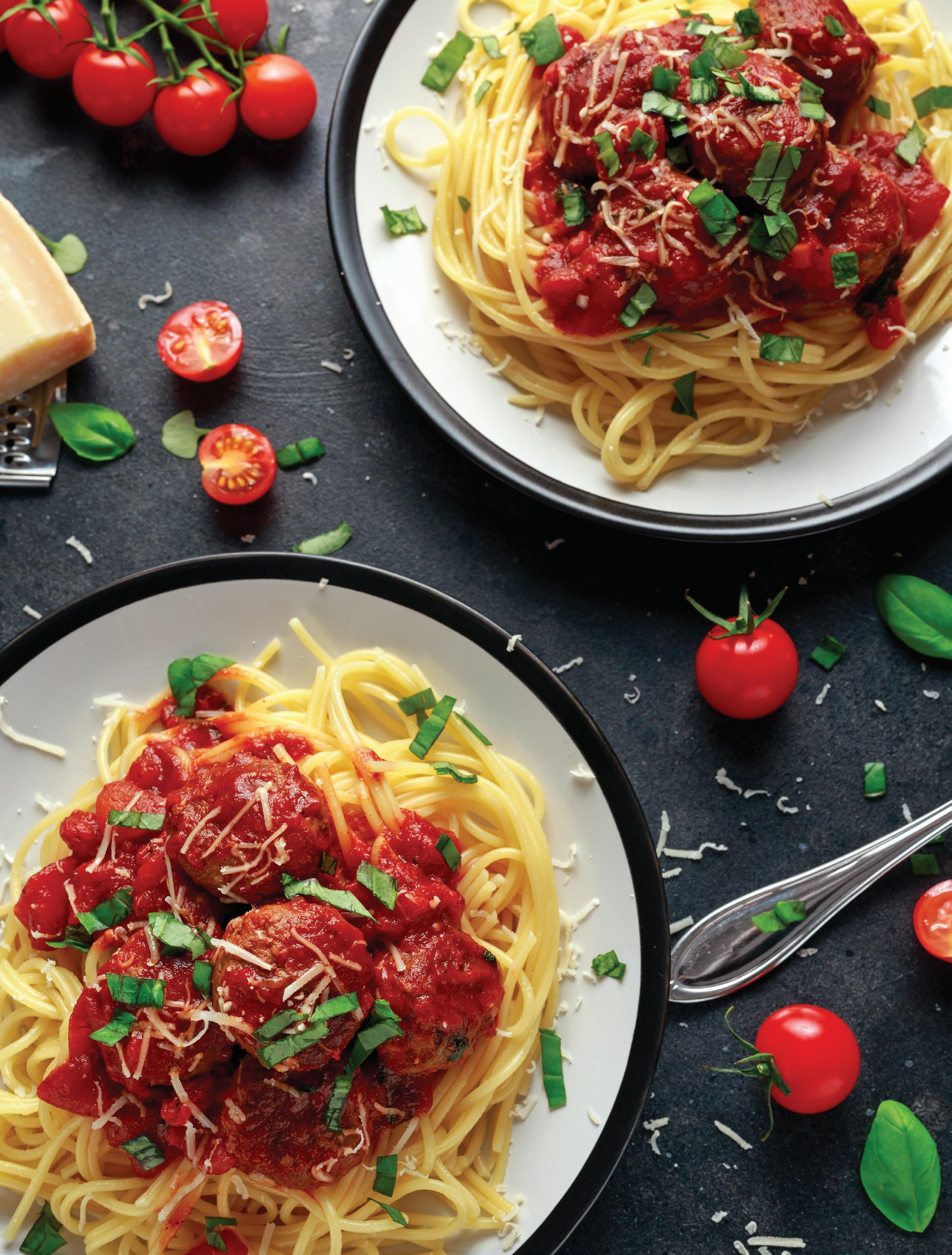
Bringing the Family Together Making Pasta
Pasta! Just this word brings so many wonderful memories to mind. If you are of Italian heritage, as I am, pasta has, of course, played a major role in your life. My Italian ancestors ate pasta with every meal. Second generation Italians living in America, today, probably don’t have pasta as a first course, or primi piatti, although I wouldn’t mind that.
My grandma, whose family was from Calabria, brought my mom and aunt to America on a ship in 1923, when they were nine and ten years old. My grandfather was a chef in the Italian Army, and he stayed in Italy but came over a bit later. The family settled in North Bergen, NJ.
During the 1950s, as I was growing up, our weekend ritual was to visit my grandparents on Sundays for dinner. I spent a lot of time in Grandma’s kitchen. We so looked forward to these meals, where we spent the whole day with family. My aunts and uncles numbered five, and the whole family would take their seats at the huge (or so it seemed to me) dining room table, with the Tiffany lamp hanging above. The aroma wafting from the kitchen was always intoxicating.
Our meal would start with a variety of antipasto, such as roasted peppers, olives, salami, cheeses, and anchovies.
The primi piatti was a pasta of some sort, be it ravioli or rigatoni, always accompanied by the wonderful Sunday gravy. And of course, there were meatballs and sausage and some sort of pork, cooked in the tomato gravy for hours. I have cherished memories of learning to cook the Sunday gravy with my mom.
The secondi was the main course, which would be anything from roast beef to chicken, with potatoes and a vegetable. Next course was the salad, followed by fruit and nuts. And, finally the dessert (which I always looked forward to).
The meal was served with my grandpa’s favorite red wine, Paisano. Everyone was given a little glass of wine, including five-year-old me! I was required to drink it with the meal. He said it helped with digestion, but I disliked the taste. Making homemade pasta for my own family started when I was in my thirties (many moons ago). My friends and I would gather and make the pasta, such as ravioli, using my pasta machine, which rolls the dough flat and thin and adjusts to our desired thickness. We would lay the dough out on a sheet atop my large dining room table and then proceed to lay the ricotta filling in lines. A wood-handled tool with a wheel on the end was used to seal the filling in the dough. Today, I still have the indelible memory of those days, since we, unknowingly, engraved straight lines down and across my pine table!
We’d make fettuccine or spaghetti and hang it from clothes hangers so it would dry. The beauty of homemade pasta is that it cooks in two minutes, and it’s so light. I’d always make a quick marinara, and when we were done, we’d sit down to a lovely lunch of pasta and a glass of wine to celebrate our accomplishments.
Years later, when my daughter and her husband would visit, we’d use the kitchen to have a “pasta day.” Using the Kitchen Aide attachments for my mixer enabled us to make a large variety of pastas. Again, add a quick sauce and enjoy a great meal.
Today, I spend special days making lasagna with my daughter and granddaughters. A good part of our day is spent assembling the lasagna, which includes the flat pasta and the gravy. In between, the layers are stuffed with ricotta, mozzarella, sausage, and meatballs. It’s a great family project.
I don’t make the Sunday gravy too often, nowadays, but I will make it, especially for company or during the holidays, because it serves so many. For a holiday dinner, such as Christmas or Easter, manicotti crepes are a favorite. These are cooked one at a time in an eight inch fry pan. Once they cool, we stuff them with a mixture of ricotta, mozzarella, Locatelli, eggs, and parsley. Baked with the Sunday gravy, these manicotti are light and fresh tasting.
Most tight knit Italian families will agree that food, and more specifically, pasta—the cooking, the eating, the smells and the taste—all add up to the nucleus around which the family gathers, and so the generational traditions carry on.


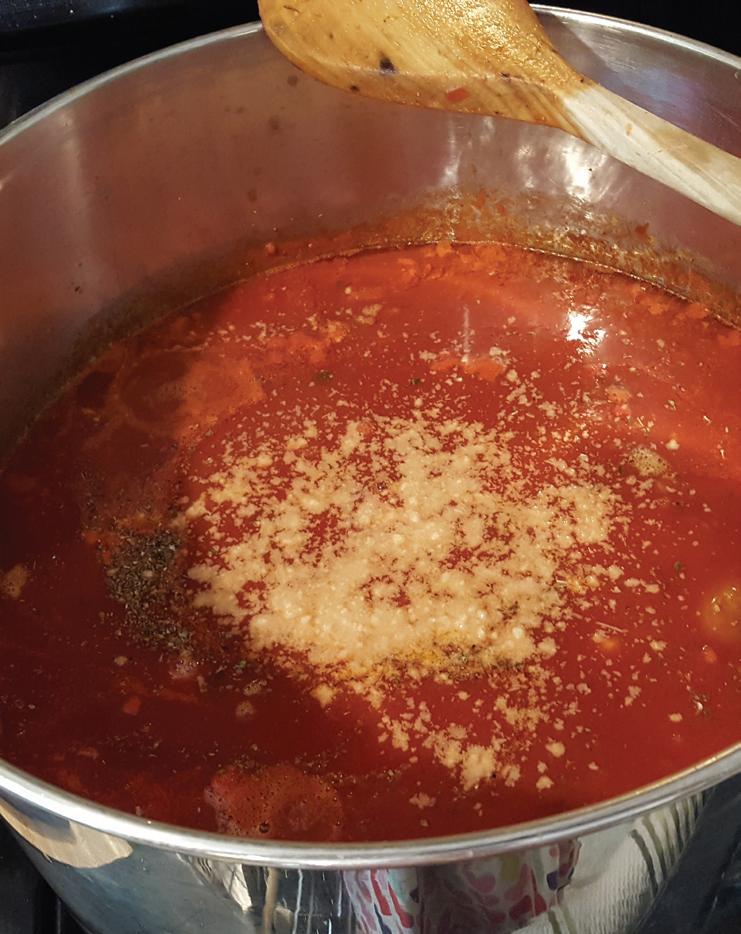
Sunday Gravy
This recipe is a combination of my mom’s and my motherin-law’s gravy. It’s been cooked over the course of our 50+ year marriage and has evolved over time. Each pot of gravy comes out a little different, depending on what meats are added. Sometimes I don’t make meatballs, sometimes no sausage, but I’ve found over the years, that it always brings me joy to share it with friends and family.
When I plan on making my gravy, I make sure I have all the ingredients in the house. That means chopped meat to make meatballs (usually beef and pork), Italian sweet sausage (or hot if you prefer), and country pork ribs. Of course, you need lots of grated Italian cheese, garlic, onion.
Let’s make a total checklist… • three pounds of chopped meat, can be all beef or with pork added • three or four eggs • Italian sweet or hot sausage, two pounds • country spare ribs (Pork always makes the gravy better.) • 1 or 2 heads of garlic • 1 large onion • 1 teaspoon dry oregano • 1 cup minced Italian parsley (some for the meatballs and some for the sauce) • hard Italian bread soaked in water until it softens • extra virgin olive oil, half a cup • anchovies, 3 or 4 (optional) • red wine, one cup (and more to drink while cooking, lol) • 1 can tomato paste • three large cans of Italian tomatoes. (I use crushed. It saves me draining the plum tomatoes) I put a huge pot on the back burner and add the tomatoes and cook over very low heat. You’ll be adding meats as you go along. On a large burner, place a large frying pan and put the olive oil in it. You want the oil to be hot, but not smoking.
Start cooking the sausage first, browning it on both sides. Set that aside and put your country ribs in the pan and brown them quickly on both sides. They don’t have to be cooked through because they finish cooking in the gravy. Once the tomatoes are very warm, you can add the sausage and ribs.
Now, it’s time to tackle the meatballs. Here’s the meatball recipe:
3-4 lbs chopped meat, can be all beef or both beef and pork 4-5 cloves garlic, minced 3 tbsp minced Italian parsley hard Italian bread, soaked in warm water til soft ¾ to 1-1/2 cups Romano or Locatelli grated cheese (less for 3 lbs chopped meat, more for 4) 4 eggs salt and pepper to taste.
Put all ingredients in a large bowl. Squeeze water from bread til almost dry and add to the mix. Mix thoroughly with your hands til all is combined. [The mixture will be soft but if it’s too soft, add some bread crumbs to make it more firm.] Start with about 1/3 cup of mixture and roll into a ball. If it’s too big, take some meat off—too small, add more meat. Try to keep them all the same size as they will cook more uniformly.
you want to be able to turn them easily. When they’re all browned, place in a bowl to rest. I always taste them at this point—fried meatballs are my favorite. You will put them in the gravy after it has simmered for an hour.
You now have a large pot of tomatoes with sausage and ribs cooking in it and a bowl of fried meatballs. You also have a large frying pan with oil and bits of meat from cooking the meatballs, sausage, and ribs. Add ¼ cup olive oil to the frying pan.
Heart of the Gravy
Next, you will need to mince 6 large cloves of garlic, 1 large onion, and ¼ cup Italian parsley. Take the can of tomato paste and mix with 1 can of hot water til there are no more lumps and it is smooth. Set this aside.
Make sure the oil is hot and add the minced garlic and onion and cook until the onion is soft, about 3 to 4 minutes. If you are planning to add anchovies, now is the time. Stir til they are totally dissolved. Quickly add the parsley and only cook for half a minute. It should still be green. Now add your wine and simmer for 5 minutes til the alcohol is gone. This will pick up the bits of meat and deglaze the pan. Then, it’s time to add the tomato paste and water you’ve set aside and stir. This mixture will add so much flavor to the gravy and darken it from the bright red color to a more mellow one. Stir it into the large pot of tomatoes, and you’re almost done.
Add 1 tsp oregano, ½ tsp sugar, salt and pepper to taste, and a small handful of cheese. Stir again and taste.
By this time, an hour has passed, and you can add your meatballs and let the gravy simmer on low heat for another 2 or 3 hours. It should thicken and smell wonderful!
When it’s done to your liking, remove some of the meat into a casserole for the table. This will give you more room to spoon gravy over the pasta.
Put an 8 qt or larger pot of salted water (around 1 tbsp) on a large burner. When it comes to a rolling boil, add the pasta of your choice and cook. Drain when done, and you’re ready to add the gravy.
Add one ladle of gravy into a clean bowl, then add the al dente pasta. Put more gravy on top and sprinkle grated cheese over it. Now, it’s ready for the table! FIN


On the Fly
When I was growing up, in Essex County, NJ, my sister, brother, and I used to spend a lot of weekends with our father going on adventures and doing fun things. He worked hard in the City all week, so weekends belonged to us, and my mom could enjoy some “me” time. My dad would take us for pony rides on the property that eventually became the Willowbrook Mall or to “The Auction” in Pine Brook to buy a slice of pizza from a vendor’s stall and bring home pickles from the wooden barrels.
Sometimes, on the way home we would stop on the side street adjacent to the Curtiss-Wright Airport in Fairfield to watch the small planes take off and land.
Curtiss-Wright was a merger of pioneers, when Glenn Curtiss (who was considered the innovator of naval aviation) merged his company, the Glen Curtiss Aeroplane and Motor Corporation, with Orville and Wilbur Wright’s Wright Aeronautical Corporation. The new corporation was formed in 1929, just before the start of the Great Depression.
So there we would sit in our 1960s era Thunderbird, with Cousin Brucie playing the songs of the time on 77WABC AM radio. We were transfixed by the twin engine planes taxiing down the runway. But, still, I never saw it coming when one day my father announced that he would like to take flying lessons.
Being the eldest, at about ten years of age, it took all the courage that I had to go up in that tiny plane with my dad and his instructor. I liken the experience to getting into a car with a teenager who is about to put the pedal to the metal for the first time…only worse. Soaring through the clouds, it was not.
Now, years later, those scary memories have faded, replaced with romantic notions of airplanes rising above the earth, having a bird’s eye view of the land below, and being wrapped in the infinite blue skies surrounding me.
Apparently, I’m not alone in my reverie. In our tristate area, we have small, local airports that cater to the many different forms that aviation can take. Some are mere strips of runway, such as the Aeroflex Andover Airport, which is located just north of Andover, NJ, within the Kittatinny Valley State Park. Situated on just twelve acres of land and with large lakes on either end of the short runway, this airport is barely visible from the street. Also housed there, since 1987, is the Andover Flight Academy where, among other things, they teach the art of flying tailwheel airplanes, otherwise known as taildraggers, on a grass strip parallel to the paved runway.
Damian DelGaizo, Flight Academy owner, explained, “Actor/pilot Harrison Ford trained here before filming the movie Six Days, Seven Nights in which he did most of the filmed piloting himself. Actor, producer, and director James Brolin, learned here as well.”
The Academy specializes in training on vintage aircraft, using a 1943 Stearman biplane, which was a World War II trainer.
If you are interested in bush flying or want to take ski flying training on a classic J3 on skis you can learn that, as well as aerobatic instruction in loops and rolls. (www. andoverflight.com)
Skydive Sussex, a skydiving school and facility, is based at the Sussex Airport in Wantage Township, NJ. Boasting the highest skydives in the northeast, this school operates seasonally from April to November by appointment. If the thrill of jumping out of an airplane is calling your name, this school specializes in tandem skydiving, so you can experience the dive all while attached to a professional instructor via a specially designed harness system. In just a few hours, a beginner can take to the skies, from 14,500 feet and enjoy the rush of freefall with a peaceful parachute ride back to the ground.
For those looking to learn how to skydive, they may register for the Advanced Freefall Program (AFP). After ten initial training jumps, the more serious skydiver can work towards the ultimate goal of achieving the USPS Class-A skydiving license. (www.skydivesussex.com)
Under the category of “I never knew that,” the Mosquito Control planes for Sussex County are also based at this airport. There are over ten thousand acres of uninhabited wetlands in the county that are inaccessible to hand spraying. As the county monitors the mosquito population, it releases aerial applications of larvacide to control mosquito-borne disease.
In Smithfield Township, PA, just north of the East Stroudsburg business district near Route 209, the Stroudsburg-Pocono Airport sits on 69 acres. This airport is home to the Lehigh Valley Health Network’s MedEvac 2, which is the primary medical helicopter transport for Monroe and Pike Counties.
Also operating on the grounds is a seasonal skydiving center, the Sky’s the Limit. The center offers college specials, group and corporate events, and even a marriage proposal package. Popular in today’s modern techno-age, you can take advantage of their Handycam or Video Package souvenir. (www.
If you’ve ever driven on Route 84 between Port Jervis and Newburgh, NY, in Orange County, you may have noticed a plane or glider coming in for a landing at the Randall Airport, situated a few nautical miles southeast of Middletown and within view of the east-bound highway. This airport offers hang glider instruction and rides through US Hang Gliding Inc. and NY & NJ Tandem Hang Gliding.
Hang gliders have wings and a framework weighing about 45 pounds. The pilot wears a harness that allows them to stand up during takeoffs if needed and lie flat during flights. According to “Fly-n-Bryon” Estes, owner of US Hang Gliding, “I’m a lifer, I’m a second generation pilot who grew up with this. As long as I can move my arms, I’m going to be flying! We work by appointment only, with tandem flights at altitudes of 1,500 feet, which go for about ten to fifteen minutes or 3,000 feet flights that last twenty to thirty minutes. Our season is midApril to mid-November and no experience is necessary, but there are passenger height and weight restrictions. As far as an age limit, my youngest was the three-year-old grandson of a pilot and my oldest was 86 years!” (www.ushanggliding.com)
Also housed at Randall Airport is the Valley Soaring Club, which teaches gliding through different membership levels, from active to associate to junior, and with different goals, from pre-solo to cross–country training. Having one of the largest junior memberships in the country, the junior club is open to students 22 years and younger and includes flight training, glider equipment, and licensed instructors who are passionate about promoting the safe practice of the sport of soaring. (www.valley soaring.org)
If your idea of a romantic getaway is to drift peacefully over the Hudson Valley in a hot air balloon, you can do this at Randall Airport, too. Housed there are three hot air balloon companies. Above the Clouds is open 7 days a week, and flights take off by appointment at sunrise. A balloon flight usually travels between five and ten miles and takes about an hour.
“When I was kid,” said owner, Chris Healy, “a hot air balloon flew over my house, and I chased after it—that was the beginning. At 13, I became an official member of a chase crew and then at 18, got my pilot’s license. I’ve been flying for 35 years!” Healy offers a champagne toast and photo keepsake and works in tandem with Vickie Ingrassia of Wandering Winds Hot Air Balloons. Upon request, Ingrassia will supply a champagne picnic prepared by a Culinary Institute graduate. (www.abovethe cloudsinc.com and www.wanderingwindshotairballoons.com)
Fantasy Balloon Flight is the other balloon company at the airport. Its owners, Ken and Lana Smith, teamed up with Orange County Choppers and were featured on an episode of Discovery Channel’s American Choppers as well as the Ellen DeGeneres Show. This married couple embrace romance as they fly side by side in their custom made His and Hers Aerostar Balloons. (www.fantasyfli ers.com)

Throughout the ages, it has been pleasing to the senses to imagine being able to fly freely through the air. Although Peter Pan used fairy dust to do it and Mary Poppins had her umbrella, we are lucky enough to have a world of local possibilities to explore if we’d like to ride the winds. If you are looking for adventure or romance or just want to take in the gorgeous views of this beautiful area that we call home, our local airports have all that and more. ................................................. Other airports in the area include the Wurtsboro Airport and Sullivan County Airport in Wurtsboro and Swan Lake, NY, respectively, the Hackettstown Airport and Blairstown Airport in Warren County, NJ, and the Flying Dollar Airport in Canadensis, PA.


The Season of Anticipation
“Here comes the sun, and I say, it’s alright.”
-George Harrison

Most of us living in a temperate region with four distinct seasons will agree that there is a unique beauty and spirit associated with each one. But for most, perhaps, spring can be understood as the most anticipated of all, primarily due to the season that proceeds it. When the warmer days finally arrive and sunlight splashes down on our faces, we celebrate moving past the long, cold, dark days of winter. Spring fever, spring cleaning, spring training are all terms that we are familiar with, and they are unique to this season. It is a season that affects us emotionally, physically, spiritually, and even financially.
According to the National Association of Realtors, this is the most popular season to buy or sell a house. Buyers are usually reluctant to move during the winter when the weather is problematic and the kids are still in school, so the spring housing market is typically very strong.
“Spring” is an old word, and it appears in many Germanic languages with the meaning “to jump” or “to run.” About 2,000 years ago, the basic Germanic form was Spreng, and about 1,000 years ago, when Old English was spoken, the term Lent (whose original meaning was “lengthen,” referring to the changes in daylight) had changed to “Sprying,” or “Spring,” and it has not changed significantly since.
Springtime refers to the season, and also to the idea of rebirth, rejuvenation, renewal, resurrection, and regrowth. Fresh buds bloom again, farmers and gardeners plant their seeds, and temperatures slowly rise. The season that we call spring also refers to the astronomical definitions of the word. It’s considered the period between the Spring or Vernal Equinox in March and the Summer Solstice in June.
The beginning of spring is not always determined by fixed calendar dates, though. The phenological and ecological definition explaining this time of year refers to biological indicators such as the blossoming of a range of plant species, the activities of animals, and the special smell of soil that has reached the temperature for microflora to flourish. In the springtime, as temperatures rise and flowers peek out of the soil to greet the sun, the body begins making adjustments of its own. Mark Twain once described these changes as spring fever: “When you’ve got it, you want...oh, you don’t quite know what it is you do want, but it just fairly makes your heart ache, you want it so.” Perhaps Twain was writing of love. After all, spring is the time when the birds are singing, the bees are pollinating, and humans are likely to be happier and more receptive to romance.
With more sunshine and increased exposure to light, our bodies become less sluggish, we have more energy, and we sleep a little less. In this season, as light hits the retina, it goes into the pineal gland and slows the production of melatonin, and that’s what gives you that light bounce in your step, the feeling of giddiness and euphoria.
As the melatonin recedes and the light affects the brain, there’s every reason to think that people will simply be more attractive to partners, especially since body image springs into consciousness this time of year. When melatonin production eases up, so does depression, so people who have manic-depression problems (bi-polar disorder) may be more manic this time of year. But every spring there is this unhappy reality: seasonal allergies constitute over 17 million outpatient doctor visits and cause untold misery.
The advent of sunshine, warm days, and bright flowers after a long dreary winter can also boost dopamine levels. Dopamine, a chemical in the brain associated with well-being, helps to stimulate happy emotions, such as the excitement of new love, making the body behave as if it’s on high alert and stimulating the brain to take note of every smile, laugh, or special moment shared with a significant other. The links between spring and romance are fun to entertain, but may never be established as fact. Human emotions are too complex, and for every new couple formed in springtime, there is one falling apart.




The start of Daylight Savings Time may bring a series of grumbles, “What do you mean we lose an hour of sleep!”...but it does have one positive perk: more sunlight during waking hours. People simply feel better with longer days, and when there’s more available sunshine, they suffer less from Seasonal Affective Disorder (SAD). So, even though weather-wise, spring can be a little slow in showing up, the days are still growing longer. Those extra hours of sunlight make a really big difference. A University of Michigan study found that being outdoors in enjoyable climates can improve memory and broaden cognitive style, which is linked to more creative thoughts. Being outdoors in pleasant weather really offers a way to reset your mind.
Not only does the meteorological cycle of the Vernal Equinox change our moods and help guide our activities, but this time of year brings with it a long history of traditions in many cultures. For Jews, Passover (Pesach) is known as the Spring Festival or Festival of Matzah. The Torah places great stress on the fact that Passover occurred in the spring, dating back to Babylonian exile. For Christians, the Easter story celebrates Christ’s resurrection, which symbolizes renewal and the triumph of life over death. The egg, an ancient symbol of new life, has been associated with pagan festivals celebrating spring, and from a Christian perspective, Easter eggs are said to represent Jesus’s emergence from the tomb and resurrection.
Rabbits have also had a long association with seasonal spring rituals because of their amazing powers of fertility. During the 17th century, a German folklore tradition of an Easter hare who brought eggs to good children was the precursor of what came to be known in today’s culture as the Easter Bunny.
Around the globe, spring is celebrated with festivals. In Japan, cherry blossom viewing, known as Hanami, has been a major spring festival for centuries, bringing the entire island-nation together as one. In Thailand, the annual Songkran Water Festival is celebrated after the Spring Equinox and is the traditional New Year’s holiday.
Throughout the world, the season of spring and its promise of renewal for plants, animals, and humans has carved out sacred rituals and traditions that have helped write the story of humanity and nurture religious beliefs for several millennia. This enduring shared experience offers stability and hope and will continue to supply poets and artists with new material forever. ......................................................................................... Martin Schmalenberg is a retired Asian Studies teacher who now spends his time with his bonsai, guitars, and two cats.



